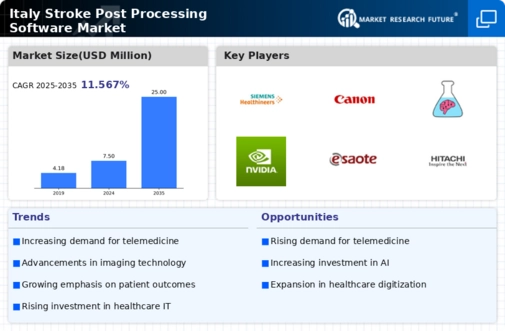Increased Focus on Telemedicine
The growing emphasis on telemedicine in Italy is influencing the stroke post-processing-software market. As healthcare systems adapt to provide remote care, the need for software that facilitates the analysis and sharing of stroke-related data has become paramount. Telemedicine allows healthcare professionals to consult with specialists and access patient data from remote locations, which is particularly beneficial for stroke patients who require timely intervention. The Italian government has allocated €300 million to enhance telehealth services, indicating a strong commitment to integrating technology into healthcare. This investment is likely to stimulate demand for stroke post-processing software that supports telemedicine initiatives, thereby expanding the market.
Rising Incidence of Stroke Cases
The increasing prevalence of stroke cases in Italy is a primary driver for the stroke post-processing-software market. According to recent health statistics, stroke remains one of the leading causes of morbidity and mortality in the country. The Italian Ministry of Health reports that approximately 200,000 new stroke cases are diagnosed annually, highlighting the urgent need for effective post-processing solutions. As healthcare providers seek to enhance patient outcomes, the demand for advanced software that aids in the analysis and management of stroke data is likely to grow. This trend suggests that the stroke post-processing-software market will experience significant expansion as hospitals and clinics invest in technology to improve diagnostic accuracy and treatment efficiency.
Growing Investment in Healthcare IT
The surge in investment in healthcare IT infrastructure in Italy is driving the stroke post-processing-software market. With the government and private sector increasingly recognizing the importance of digital health solutions, funding for healthcare IT initiatives has seen a notable increase. In 2025, investments in healthcare technology are projected to exceed €1 billion, focusing on improving data management and patient care. This financial commitment is likely to facilitate the development and adoption of innovative stroke post-processing software, as healthcare facilities seek to modernize their operations and improve patient outcomes. The influx of capital into healthcare IT is expected to create a favorable environment for the growth of the stroke post-processing-software market.
Technological Advancements in Imaging
Technological innovations in imaging modalities, such as MRI and CT scans, are propelling the stroke post-processing-software market forward. Enhanced imaging techniques allow for more precise visualization of brain structures and blood flow, which is crucial for stroke diagnosis and treatment planning. The integration of sophisticated software that can analyze imaging data in real-time is becoming increasingly vital. In Italy, the healthcare sector is witnessing a shift towards adopting these advanced imaging technologies, with investments reaching approximately €500 million in the last fiscal year. This influx of capital into imaging technology is expected to drive demand for complementary software solutions, thereby fostering growth in the stroke post-processing-software market.
Aging Population and Healthcare Demand
Italy's aging population is a significant driver of the stroke post-processing-software market. As the demographic shifts towards an older age group, the incidence of stroke is expected to rise, necessitating advanced post-processing solutions. The National Institute of Statistics in Italy projects that by 2030, over 25% of the population will be aged 65 and older. This demographic trend suggests an increasing burden on healthcare systems, prompting the need for efficient software that can assist in the management and analysis of stroke cases. Consequently, healthcare providers are likely to invest in stroke post-processing software to enhance their capabilities in addressing the needs of an aging population.





















Leave a Comment